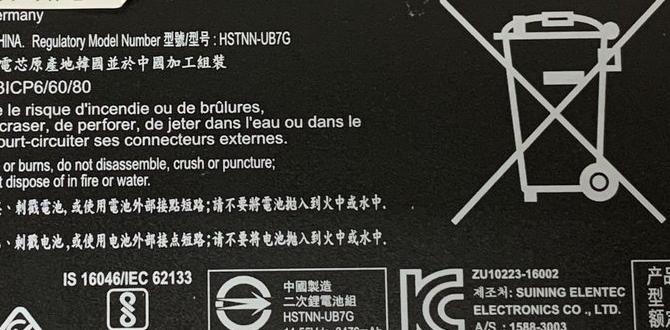Quick Summary: Install a secure battery rack to organize, protect, and ensure safe access to your batteries. This essential power storage solution prevents damage and makes maintenance straightforward, keeping your systems running smoothly and reliably.
Ever looked at a pile of batteries, maybe for your car, a power tool, or even just around the house, and thought, “There has to be a better way”? It’s a common feeling! Loose batteries can be a safety hazard, get damaged easily, or just be plain messy. Finding the right battery storage solution ensures they last longer and are ready when you need them. We’re going to walk through everything you need to know about battery racks, making your power storage simple, safe, and super organized. Let’s get your battery setup sorted!
What Exactly is a Battery Rack and Why Do You Need One?
Think of a battery rack as a designated, safe home for your batteries. Instead of them rolling around, being stacked precariously, or getting lost, a rack keeps them neatly arranged and protected. These racks are designed to handle the specific needs of different battery types, from hefty car batteries to smaller household ones.
For car batteries, a proper rack is often part of the vehicle’s structure, physically holding the battery in place. This prevents it from shifting during driving, which could cause damage to the battery itself or other parts of your car. For backup power systems or industrial setups, battery racks are usually specialized shelving units designed to hold multiple batteries securely and safely.
The main reasons you’d want a battery rack are:
- Safety: Prevents short circuits, leaks, and physical damage.
- Organization: Keeps your batteries tidy and easy to access.
- Longevity: Protects batteries from damage that can shorten their lifespan.
- Efficiency: Makes maintenance, like checking fluid levels or cleaning terminals, much easier.
- Compliance: In some professional or industrial settings, regulations require proper battery storage.
Types of Battery Racks: Finding the Right Fit
Not all battery racks are created equal. The best type for you depends on what kind of batteries you’re storing and where.
Car Battery Trays and Holders
In most vehicles, the car battery sits in a specific tray or is secured by a clamp system. This isn’t just for show; it’s crucial for safety. These trays are usually made of robust plastic or metal and are designed to withstand vibrations and impacts.
Key Features:
- Secure Clamping: Holds the battery firmly in place.
- Acid Containment: Some trays are designed to catch minor acid leaks.
- Ventilation: Allows gasses produced by the battery to escape safely.
If your car battery holder is damaged or missing, replacing it is a must. You can usually find these specific to your car’s make and model at auto parts stores or dealerships.
Industrial and Backup Power Battery Racks
For larger battery banks, like those used in uninterruptible power supplies (UPS), solar power storage, electric vehicle charging stations, or backup generators, you’ll need more substantial racking systems. These can range from simple shelving units to elaborate, floor-to-ceiling structures.
Common Types:
- Shelving Units: These are like heavy-duty bookshelves designed to hold individual batteries or battery trays. They are often made of steel and can be configured to fit various spaces.
- Cabinet Systems: Enclosed units that offer extra protection from dust and physical impact, and can also provide better ventilation control.
- Wall-Mounted Racks: Useful for saving floor space, especially for smaller battery banks.
- Freestanding Racks/Frames: Robust structures that can support significant weight and are often used for large-scale installations.
Power Tool Battery Charging Stations
For the DIY enthusiast or professional who uses many cordless power tools, a charging station or rack can be a game-changer. These are designed to hold multiple chargers and batteries, keeping everything organized and ready to go.
Benefits:
- All-in-One Storage: Charges and stores batteries and chargers together.
- Reduces Clutter: Eliminates tangled cords and scattered chargers.
- Quick Access: Grab a fully charged battery in seconds.
Universal Battery Organizers
For smaller batteries like AA, AAA, C, D, or 9V, there are many small organizer boxes and cases available. These are more about keeping batteries from getting lost and protecting them from shorting out in drawers.
Why Use Them:
- Prevents Accidental Discharge: Stops batteries from touching metal objects.
- Easy Inventory: See at a glance what batteries you have and how many.
- Portability: Great for keeping spare batteries in your car, toolbox, or backpack.
Choosing the Right Battery Rack: What to Consider
Selecting the right rack involves looking at a few key factors. Getting this right ensures your batteries are stored safely and effectively.
1. Battery Type and Size
This is the most important consideration. A rack for a car battery will be very different from one designed for small AA batteries or large industrial lithium-ion packs. Measure your batteries carefully and check the specifications of any rack you’re considering to ensure a proper fit.
2. Weight Capacity
Batteries, especially multiple car or industrial batteries, are incredibly heavy. The rack you choose must have a weight capacity comfortably exceeding the combined weight of the batteries it will hold. Exceeding this limit can lead to catastrophic failure of the rack and serious safety hazards.
For reference, a typical car battery weighs around 30-50 pounds (13-23 kg). Industrial batteries can weigh hundreds of pounds.
3. Material and Durability
The material should be sturdy and resistant to corrosion, especially if batteries might leak acid. Steel is common for heavy-duty racks, while robust plastics are used for car battery trays and smaller organizers.
4. Ventilation and Fire Safety
Batteries can produce flammable gases as a byproduct of their normal operation or charging. Proper ventilation is crucial to prevent gas buildup. For larger installations, fire-retardant materials and compliance with safety standards are important. Consult resources like the National Fire Protection Association (NFPA) for guidelines relevant to your specific situation.
5. Location and Space
Where will the rack be installed? Consider available floor space, wall space, and ceiling height. Ensure there is enough room to safely install, access, and maintain the batteries. Avoid areas with extreme temperatures or direct sunlight, as these can affect battery performance and lifespan.
6. Ease of Access and Maintenance
You need to be able to easily get to your batteries for checking connections, cleaning terminals, or replacing them. The rack design should not impede these necessary tasks. For car batteries, ensure you can remove and reinstall them without excessive difficulty or risk.
7. Environmental Considerations
Some battery types require specific environmental conditions. For example, lead-acid batteries should not be stored in living spaces due to potential off-gassing. Lithium-ion batteries can be sensitive to heat and cold.
Installation: Getting Your Battery Rack Set Up
The installation process varies greatly depending on the type of rack. Here’s a general guide:
Installing a Car Battery Tray/Holder
This often involves placing the new tray in the designated spot in your car and securing it. Then, the battery is placed in the tray and clamped down firmly.
Tools You Might Need:
- Wrench or socket set (to remove old hold-downs)
- Screwdriver
- Gloves (especially if working near an old battery)
- Safety glasses
Steps:
- Disconnect Old Battery: If replacing an existing system, always disconnect the negative terminal first, then the positive.
- Remove Old Holder: Unscrew or unbolt any clamps or brackets holding the old battery in place. Lift out the old battery carefully.
- Position New Tray: Place the new battery tray in the designated mounting location in your vehicle. Ensure it sits flat and securely.
- Secure Tray: If the tray needs to be bolted down, fasten it securely using appropriate hardware.
- Place New Battery: Carefully lower the new battery into the tray. Make sure it fits snugly.
- Secure Battery: Reinstall the hold-down clamp or bracket, ensuring the battery is firmly secured and cannot move.
- Connect Terminals: Connect the positive terminal first, then the negative terminal. Tighten them securely but don’t overtighten.
- Check for Stability: Gently try to rock the battery. It should not move at all.
Important Safety Note: Car batteries contain sulfuric acid and can produce flammable hydrogen gas. Always wear eye protection and gloves, and work in a well-ventilated area. Never smoke or create sparks near a battery.
Installing Heavy-Duty Shelving or Cabinet Racks
These installations are more involved and often require assembly. Follow the manufacturer’s instructions precisely.
General Steps:
- Prepare the Area: Clear the space where the rack will go. Ensure the floor is level and can support the weight.
- Assemble Components: Unpack all parts and identify them using the instruction manual. Assemble the frame, uprights, and shelves according to the directions. This might involve bolting pieces together.
- Secure to Wall (if applicable): If it’s a wall-mounted or seismic-braced system, ensure it’s properly anchored to wall studs or concrete as specified by the manufacturer and local building codes. This is crucial for safety, especially in areas prone to earthquakes.
- Install Bracing: Add any cross-braces or support bars for stability.
- Verify Stability: Once assembled and secured, check that the rack is level, stable, and doesn’t wobble.
- Place Batteries: Carefully place batteries onto the shelves, distributing weight evenly and respecting the maximum load per shelf.
For large industrial racks, it’s often best to consult with a professional installer to ensure safety and compliance with regulations.
Battery Rack Maintenance: Keeping Things Running Smoothly
A battery rack, just like the batteries themselves, needs a little attention to stay in top shape.
Regular Inspections:
- Check for Damage: Look for any signs of corrosion, cracks, bending, or loose fastenings.
- Verify Stability: Ensure the rack is still securely in place and the batteries are firmly held.
- Cleanliness: Keep the rack and the surrounding area clean and free of debris, especially dust, which can accumulate and become a fire hazard.
Battery-Specific Checks (for lead-acid batteries):
- Terminal Cleaning: If you see white or bluish powdery residue (corrosion) on battery terminals, clean it using a wire brush and a mixture of baking soda and water. Apply a thin layer of petroleum jelly or specialized terminal grease after cleaning to prevent future corrosion.
- Fluid Levels: For serviceable lead-acid batteries (those with removable caps), check the electrolyte level. If it’s low, carefully add distilled water only until the plates are covered. Never overfill.
- Ventilation Ports: Ensure any vents on the battery or in the rack are clear and not blocked.
Environmental Monitoring:
- Temperature: Keep an eye on the temperature around your batteries. Extreme heat or cold can degrade performance and shorten lifespan.
- Moisture: Ensure the area is dry. Excessive moisture can lead to corrosion and other issues.
This proactive maintenance can prevent problems before they start and help you get the most out of your battery investment.
Safety First: Essential Precautions with Battery Racks
Batteries store a lot of energy, and mishandling them or their storage can lead to serious incidents. Here are critical safety tips to remember:
- Wear Protective Gear: Always wear safety glasses and gloves when handling batteries or working around battery racks, especially lead-acid types.
- Ventilation is Key: Ensure adequate ventilation to prevent the buildup of flammable hydrogen gas. Never store batteries in sealed, unventilated spaces. The Occupational Safety and Health Administration (OSHA) provides comprehensive guidelines for battery charging and handling.
- Grounding: For larger battery systems, proper grounding of the rack and associated equipment is essential to prevent static discharge and electrical hazards.
- Weight Limits: Never exceed the weight capacity of your battery rack.
- Corrosion Control: Regularly inspect for and clean off any signs of battery acid corrosion.
- Secure Installations: Ensure all heavy racks are securely anchored to prevent tipping or falling.
- Keep Flammables Away: Store batteries and their racks away from open flames, sparks, and other combustible materials.
- Spill Containment: Have a plan and materials ready to deal with potential battery acid spills.
Battery Rack Materials: A Closer Look
The materials used in battery racks are chosen for their strength, durability, and resistance to the specific conditions batteries present.
| Material | Pros | Cons | Typical Use Cases |
|---|---|---|---|
| Steel (Powder-Coated or Galvanized) | Very strong, durable, high weight capacity, resistant to corrosion when treated. | Can be heavy, needs proper coating to prevent rust, can be more expensive. | Industrial battery racks, heavy-duty shelving, car battery trays. |
| Aluminum | Lightweight, highly corrosion-resistant, good strength-to-weight ratio. | Lower weight capacity than steel, can be more expensive than steel. | Specialized racks, some vehicle applications, smaller industrial systems. |
| High-Impact Plastic (e.g., Polypropylene, ABS) | Resistant to acid and corrosion, lightweight, cost-effective for smaller applications, often molded for specific battery shapes. | Lower weight capacity than metal, can become brittle in extreme cold or with UV exposure. | Car battery trays, battery organizers, charging station components. |
| Wood | Inexpensive, easy to work with for DIYers. | Absorbs acid and moisture, can degrade quickly, may not be fire-retardant, lower weight capacity unless heavily reinforced. | Limited DIY applications for small, non-critical battery storage; generally not recommended for car or industrial batteries. |
Troubleshooting Common Battery Rack Issues
Even with the best setup, you might run into small problems. Here’s how to tackle them:
- Rack Wobbles or Feels Unstable:
- Cause: Uneven floor, loose bolts, insufficient bracing.
- Solution: Check all connections and tighten bolts. Use shims to level the base on uneven floors. Ensure all safety bracing is installed correctly. For wall-mounted units, check wall anchors.
- Corrosion on Rack or Battery Terminals:
- Cause: Battery leakage, moisture, age.
- Solution: Clean terminals with a baking soda and water paste. If the rack itself is significantly corroded, depending on the material, you might need to clean it, treat it (e.g., with a rust converter for steel), or replace the affected part. Ensure batteries are upright and not leaking.
- Battery Doesn’t Fit Properly:
- Cause: Incorrect rack purchased, battery dimensions slightly different from standard, rack not fully assembled.
- Solution: Double-check the battery dimensions against the rack specifications. Ensure the rack is fully and correctly assembled. If it’s a car battery tray, ensure you have the correct model for your vehicle. Sometimes minor modifications (if safe and appropriate) might be needed, but often it’s better to get a different rack.
- Difficulty Accessing Batteries:
- Cause: Poor rack placement, too many batteries, obstructed access.
- Solution: Re-evaluate the layout. Ensure there’s enough space around the rack for safe access. If possible, rearrange batteries or consider a different rack system that offers easier access.
When to Upgrade or Replace Your Battery Rack
Your battery rack isn’t meant to last forever, especially if it’s a critical part of



